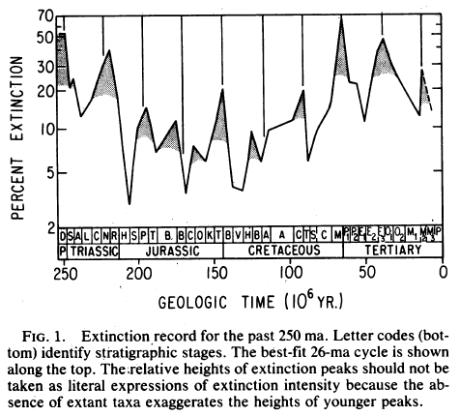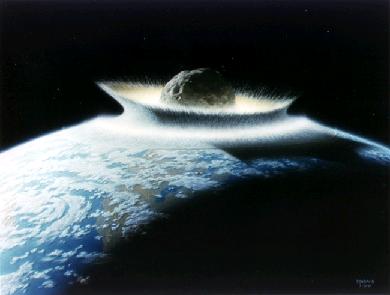In 1984, paleontologists David Raup and Jack Sepkoski of the Department of Geophysical Sciences, University of Chicago, published a paper claiming that they had identified a statistical periodicity in extinction rates over the last 250 million years. In his research, Sepkoski prepared a listing of about a quarter of a million species of sea-dwelling creatures, both extinct and current, noting the point in time where they appeared and became extinct. Sepkoski confined the study to marine organisms because the chances of finding fossils are much higher under the sea-bed. The oceans are areas of net sedimentation, whereas land is an area of net erosion, which means fewer rocks and fossils are found on land.
Although the study was originally devised to be a broad study of the distribution of marine life through geologic time, it, quite unexpectedly turned into a critical component of the mass extinction debate. David Raup, a senior colleague at the University of Chicago, suggested that Sepkoski examine the date for any evidence of a pattern in the timing of the mass extinctions. To further study extinction periods Sepkoski decided to concentrate on the last 250 million years of geologic time and to throw out animals whose point of appearance and disappearance were debated. He was left with about 500 of his original 3,500 marine families (250,000 species). Sepkoski put the data through computer analysis and was surprised to find that life forms on earth disappeared in great numbers approximately every 26 million years. Both of them checked for errors and confirmed the pattern; life seemed to disappear drastically exactly every 26 million years. In the paper Raup and Sepkoski wrote:
“The temporal distribution of the major extinctions over the past 250 million years has been investigated statistically using various forms of time series analysis. The analyzed record is based on variation in extinction intensity for fossil families of marine vertebrates, invertebrates, and protozoans, and contains 12 extinction events. The 12 events show a statistically significant periodicity (P <0.01) with a mean interval between events of 26 million years. Two of the events coincide with extinctions that have been previously linked to meteorite impacts (terminal Cretaceous and late Eocene). Although the causes of the periodicity are unknown, it is possible that they are related to extraterrestrial forces (solar, solar system, or galactic.)”
Raup and Sepkoski had also explored the possibility of the existence of a longer cycle, but they had discounted it as a weaker description of the data. In their original paper they wrote that, “It is possible that the appearance of a 26 Myr cycle actually results from a longer cycle of, say, 52 Myr in combination with a scattering of random events. This model has been tested and found to be a weaker description of the data than the simple 26 Myr cycle.” The 26 million year cycle has since been corroborated by a number of detailed analyses carried out by Sepkoski, Rampino, Caldeira and other scientists, which establishes the periodicity of the mass extinction events.

|
Fig 2: The original extinction data of Raup and Sepkoski. This plot represents the extinction rate (vertical axis) vs. time (horizontal axis). The extinction rate peaks every 26 million years, which are marked by the arrows. Source: Raup and Sepkoski (1984) |
The extinction of the dinosaurs 65.5 million years ago has since been followed by two more extinction events. We can find a surprising correlation between the mass extinction dates calculated by scientists and those arrived at from the Vedic texts. According to the Vishnu Purana, we are now at the middle of the first day of the 51st year of Brahma. In the current Day of Brahma, 453 Mahayugas have elapsed out of a total of 1000 Mahayugas that comprise it. Since a Day of Brahma lasts for 12 million years, this means that it has been roughly 5.5 million years since the beginning of the current Day of Brahma. Therefore, the most recent destruction event would have taken place (5.5 + 12) i.e. 17.5 Myr (million years ago). Using this data we can infer that, as per the Sanskrit texts, the last five destruction events should have taken place as per the following timelines: 17.5 Myr, 41.5 Myr, 65.5 Myr, 89.5 Myr, and 113.5 Myr. When we compare this to the extinction dates that were computed by Raup and Sepkoski from the fossil records i.e. 11.3 Myr, 38 Myr, 65 Myr, 91 Myr and 125 Myr we can find a very close correlation. And, quite incredibly, there is an exact match with the extinction event that wiped out the dinosaurs 65.5 million years ago!
In case of some of the extinction events, there is a slight difference between the dates calculated from the Vedic texts, and those computed by Sepkoski. We should remember that the extinction timelines calculated by Sepkoski are approximate, and depend on the sample characteristics and various assumptions inherent in the model. Other scientists have arrived at slightly different values for the extinction events. For instance, the most recent extinction event, which has been termed as the Middle Miocene disruption, is now considered to have taken place during the middle of the Miocene Epoch, nearly 14.8 – 14.5 Myr. This is much closer to the value arrived at from the Vedic texts (17.5 Myr). We should also remember that the duration of the Precessional Year is not constant, and may fluctuate around the Mean Value of 24,000 years. If this is correct, then the duration of a Day and Night of Brahma will also fluctuate around a Mean Value of 24 million years. The periodicity of these fluctuations needs to be understood and considered in order to correctly calculate the previous dates of cosmic destruction.
It would be fair to conclude on the basis of the above analysis that, the 24 million year cycle of creation and destruction, comprising of a Day and Night of Brahma, is embedded in the fossil records of the planet earth. However, the Vedic texts also give us some very specific information about this grand cycle. They tell us that new life forms suddenly appear after a gap of 12 million years from the mass extinction event. Is this curious fact also reflected in the fossil records? Although there is no doubt that fundamentally new life forms appear after an extinction event, we do not know if the new life forms appear after a gap of 12 million years. This is possibly because no scientist has consciously investigated such a hypothesis. What we do know, however, is that paleontological records show that new life forms appear very abruptly (within a space of a few thousand years) after long periods of environmental stasis, extending for million of years. This is known as ‘Punctuated Equilibrium’, a theory that was developed independently by Harvard paleontologists Steven Jay Gould and Niles Eldredge in 1972. It would certainly be interesting if scientists were to take a fresh look at the fossil samples to detect the presence of a 12 million year gap between the extinction and creation events.
Even now, there is no consensus in the scientific community regarding the possible trigger for these periodic extinction events, although scientists agree that there must be a single underlying cause. Raup and Sepkoski had favored extraterrestrial factors in their original analysis:
“A first question is whether we are seeing the effects of a purely biological phenomenon or whether the periodic extinction results from recurrent events or cycles in the physical environment. If the forcing agent is in the physical environment, does this reflect an earthbound process or something in space? If the latter, are the extraterrestrial influences solar, solar system, or galactic? Although none of these alternatives can be ruled out now, we favor extraterrestrial causes for the reason that purely biological or earthbound physical cycles seem incredible, where the cycles are of fixed length and measured on a time scale of tens of millions of years. By contrast, astronomical and astrophysical cycles of this order are plausible even though candidates for the particular cycle observed in the extinction data are few. One possibility is the passage of our solar system through the spiral arms of the Milky Way Galaxy, which has been estimated to occur on the order of 100 million years. Shoemaker has argued that passage through the galactic arms should increase the comet flux and this could, following the Alvarez hypothesis, provide an explanation for the biological extinctions. Two of the extinction events considered here (Late Cretaceous and Late Eocene) are associated with evidence for meteorite impacts. However, much more information is needed before definitive statements about causes can be made.”
The link between the mass extinction event that eliminated the dinosaurs, and meteorite impacts from outer space, was known for a few years before Raup and Sepkoski had published their paper. In 1980, the Alvarez group proposed the asteroid impact theory to explain the sudden extinction of dinosaurs at the K-T (Cretaceous–Tertiary) boundary, some 65.5 million years ago. A team of researchers, which included Nobel prize-winning physicist Luis Alvarez and his son, geologist Walter Alvarez, discovered that sedimentary layers found all over the world at the K-T boundary contain a concentration of iridium many times greater than normal (30 times background in Gubbio, Italy and 160 times at Stevns). Since Iridium is extremely rare in the earth's crust but is abundant in chondritic meteorites and asteroids (the isotopic ratio of iridium in asteroids is similar to that of the K–T boundary layer but significantly different from the ratio in the Earth's crust) the Alvarez team suggested that the iridium spike at the K-T boundary is extraterrestrial in origin and had settled out of a global dust cloud triggered by the impact of an asteroid 10 km in diameter. They proposed that this giant asteroid crashed into the earth at nearly 90,000 km/hr and produced an impact crater of diameter 250 km, which led to the extinction of the dinosaurs.

|
Fig 3: An artist's concept of a catastrophic asteroid impact with the Earth. Source: NASA |
Raup and Sepkoski, Proc. Natl. Acad. Sci. USA, Vol 81, pp 801-805, February 1984